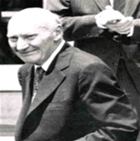Inductee Profile
Ernst Weber
 Ernst Weber was born in Vienna, Austria in 1901. The impact of his family influenced him greatly in learning about and later choosing a career in the sciences. After graduating from college and earning his engineering diploma in 1924, he began to work for the Siemens Corporation. Here he worked on a series of projects including conformal mapping and solving problems within the mining industry. At this time he continued with his education and received a Ph.D. in electrical engineering in 1927. His dissertation topic was to find why deviations in electronic charges occur and resolving the discrepancy between Ehrenhafts' experiments and Millikan's theory.
Ernst Weber was born in Vienna, Austria in 1901. The impact of his family influenced him greatly in learning about and later choosing a career in the sciences. After graduating from college and earning his engineering diploma in 1924, he began to work for the Siemens Corporation. Here he worked on a series of projects including conformal mapping and solving problems within the mining industry. At this time he continued with his education and received a Ph.D. in electrical engineering in 1927. His dissertation topic was to find why deviations in electronic charges occur and resolving the discrepancy between Ehrenhafts' experiments and Millikan's theory.
Weber eventually left Germany because of the rise of Nazism and came to the U.S. Here he became an educator along with being a scientist. His interest in the educational systems and specifically the differences between an American approach from a European design led him to teach and prepare future engineers in new ways. His work in this area eventually led to his being named President of the Polytechnic Institute of Brooklyn. Though his impact on education was considerable--he helped train a generation of Americans at Polytechnic--he continued to do research, notably on efforts involved with radar. During World War II he was chairman of the Basic Science Group of AlEE and later joined MIT's Rad Lab. He also worked closely with his graduate students on a series of American corporations on developing radar and related projects, including Airborne Instrument Laboratories, Corning Glass, Sperry, Harris-Intertype, Hewlett-Packard. He also established the Polytechnic Research Development Corporation, later sold to Harris-Intertype in 1959.
In 1952 he organized the Microwave symposia and became President of IRE in 1959. He resigned as President of Polytechnic in 1969. He then joined the Advisory Committee for the Division of Engineering of the National Research Council and later became its chairman. He worked here until 1978. He was also involved in centralizing the engineering societies in the U.S. After Polytechnic he began to study and work with organizations concerned with such diverse topics as limiting automobile pollution and predicting earthquakes. Weber continued to work as a volunteer for IEEE until his death in February 1996.
During his lifetime, Dr. Weber held more than 30 American, Canadian and British patents in the field of microwave techniques and wrote more than 50 publication papers on electromagnetic field, linear and nonlinear circuits and microwave measurements. He was the recipient of honorary degrees from six institutions and was awarded the Presidential Certificate of Honor in 1948 by President Harry Truman and the National Medal of Science in 1987 by President Ronald Reagan.